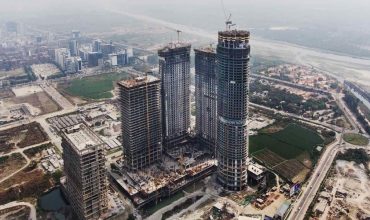Buying a property is no less than a dream come true occasion, especially, when it’s your first one. The importance of buying a property is similar to that of getting it named. While Indian property registration can sometimes be tricky, but the easiest way is to follow the procedure. This procedure is certainly time-consuming and complex, as various documents and procedures are prescribed to be followed. Any property transfer consists of certain people, who become part of the project. Two most important parties are the buyer and the seller. In the process of registration, a buyer is required to pay a fee which is called the registration fee attached to the stamp in order to transfer his name.
As per the guidelines set by the government concerning the sale of immovable property, only an Indian citizen, Indian origin person or an NRI can purchase a property in India. Being an Indian origin individual, a person should not be a citizen of Bangladesh, Pakistan, China, Nepal, Bhutan Iran, and Sri Lanka. Section 17 of the registration act of 1908 is considered for any purchases made in India with respect to land and property. The Jammu and Kashmir states have got an exemption from the act, although, after removal of clause 370, the registration is now valid in Jammu and Kashmir. The act maintains solidarity in terms of records and correctness. The process of registration includes stamp duty, registration fee and submission of major documents to the registrar. There is a certain differentiation in the processes, depending upon the first time sale or secondary sale of the property. The first time case requires complete procedure with increased complications, however, the other one may restrict to stamp duty and transfer deed registration.
ALSO READ: How to Double Your Money by Investing in Commercial Real Estate
Estimation of Payable Amount
The tax imposed by the state government on the buyers of the property is called stamp duty and has a potential significance in the entire process. The stamp duty is controlled by the particular state government. Due to varied governments in the states, the rates of these stamp duty varies from region to region. The rate is usually based on either a particular percentage of the concerned property or the current circle rate declared by the authorities. The higher rate out of the two will be considered. A substantial variation can be seen in the duties specified for the rural and urban areas. Also, there are certain benefits offered to women as the fee is comparatively low when the buyer is a woman. So the first step is the estimation of the stamp duty or registration fee.
Final Sale Deed Preparation
A sales deed is the foremost document prepared in the procedure as it constitutes the highest value. A lawyer from the buyer’s side is required to prepare the sales deed on a valid stamp paper or an e-stamp paper. Both the papers are easily available in the concerned areas. A licensed lawyer on behalf of the buyer would be recommended to make the deed. Before the submission, the document is required to be embossed a legal paper of green color with no mentions on the place and date area. The lawyer’s fee varies, yet a general estimation is around 1 percent with a time required about a week.
ALSO READ: 10 Best Commercial Property Investment projects Noida
Documentation and Submission
The process of submission will require the presence of all the parties, i.e. the seller, buyer, and two witnesses. They all have to report in the concerned Sub-registrar of Assurance office, which is the one present in the property’s jurisdiction area. The parties are required to sign on the sales deed, showing their agreement in the transaction. Once the signatures are done and the documents are submitted then, the sub-registrar lots the distinct number on the documentation.
Payment of Registration Fee
The next step is presenting the documentation to the Sub-registrar of assurances’ reader as he is required to inspect the documents. After approval, the reader will ask for the submission of the registration fee or stamp duty. The fee is usually paid before the stamp duty and is one percent of the transaction value, also it can be Rs 30,000, the lesser one. Once the registration fee has been submitted, then a receipt is allotted by the cashier after which as per the Registration Act of 1908’s section 32, the documentation should be presented to the Sub-Registrar. It takes half-an-hour for the sub-registrar to go through the documents, after which he returns it. Once this is done, the buyer can get the hold of the property by the seller.
ALSO READ: Jewar Airport Impact on Delhi-NCR Real Estate
Requisites or Documents
The list of documents required for the registration are:
- The document’s duplicate copies are required to be registered.
- Buyer’s, seller’s and witnesses’ passport size photos, two each.
- Buyer’s, seller’s and witnesses’ photo identity proofs, like driving license, voter’s id card or pan card.
- In order to ensure the ownership of property, the recent property register card is to be submitted. The city survey department will be able to provide it.
- To ensure the year of property construction, municipal tax bill or its copy would be submitted.
- Buyer’s and seller’s pan cards attached with the sale deed.
- The seller’s buyer’s and witnesses’ signatures and thumb impressions are compulsory.
Despite the complicated overview, the time required for the entire process is not more than a day.
Collecting Registered Documents
The returned documentation will be the original ones, however, the duplicate or the copy of documents would stay with the registrar itself. The copy is kept with the registrar as its important to maintain a record of such transactions, following their requirements for future secondary sales of a similar property. The details of the registration will be recorded in the registered documents mentioning the book and page number.
The complete registration process takes a span of a month, that includes preparation of documents, sales deed, appointment and submission to the registrar. Apart from registration fees and the stamp duty, the amount payable is 100 Rs for the application fee, 100 Rs for an affidavit, 200Rs for indemnity bond and notary charges worth 50Rs.
ALSO READ: 6 Essential Things Related to TDS on Property Sales
By receiving the letter of mutation, the buyer gets the right to utilize the property as per his or her own will. Multiple property agents, lawyers, and brokers are available in the market, who offer assistance for this highly complex procedure consisting of plenty of steps. The registration is required to be carefully executed with no exception in the adherence to the prescribed guidelines, as it might create problems in the later front. Also, all the individuals are required to carefully secure the documents of the registration as any failure in their safety can cause serious issues.





Nevada
Thank you for this valuable information.
Eb
Thank you for this valuable information.